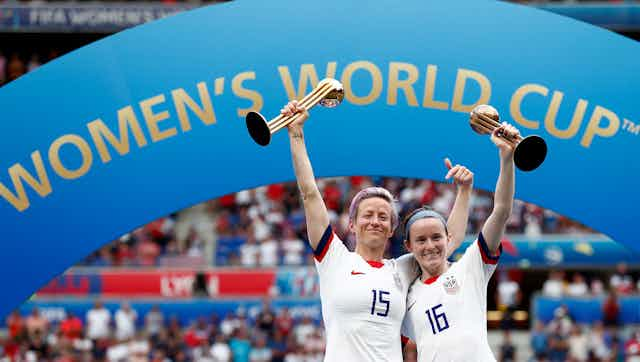Cast your mind back to the summer of 2019. By the second week of July, the FIFA Women’s World Cup had just come to a thrilling climax in Lyon, France. The USA collected their fourth trophy and the tournament attracted more than one billion viewers across the globe. In the UK, the city of Liverpool was about to host the netball World Cup and the annual Wimbledon tennis championship was underway.
There was a buzz about women’s sport in the British media like perhaps never before. The BBC referred to it as the “summer of women’s sport”, launching the female-led #changethegame media campaign. In research commissioned by the Women’s Sport Trust, a six-week period between June 7 and July 14 found near parity in the coverage of women’s sport compared to men’s sport. On the BBC Sport website, nearly half of the homepage stories featured women’s sport, and it also made up over half of the “most-watched” video clips.
While these statistics may seem unsurprising for some – after all, women make up half of the population – academic research has long highlighted gender inequality in sport media coverage across the globe. Researchers have looked into the proportion of coverage allotted to women’s sport by both print and broadcast media and found it to average about 4%. This abysmal level has been persistent – rarely creeping over 10%, despite fluctuations seen during exceptional moments such as the Olympics, the World Cup or, as I found in my own research, when women compete against men.
It appears that when we have seen positive shifts in the volume of women’s sport coverage, it’s often when men’s sport is absent. This was the case in the summer of 2019 – when the men’s football season restarted in August it was business as usual.

Fast forward to the summer of 2020. The landscape of elite women’s sport in the UK has been decimated by the global COVID-19 pandemic, with sporting leagues ended prematurely or voided completely. As men’s football in England takes its first post-lockdown competitive steps – albeit in empty, multi-million pound stadiums – and other men’s sports make their own attempts to return safely to competition, the widespread cancellation of women’s sport has been seen as indicative of women’s subordinate position in sport more broadly.
One of the first sports that the British government indicated as suitable for socially distant competition was golf. The leading male golfers in the world on the PGA teed off last week at the Colonial Country Club in Texas. There’s an irony in the fact that this was the venue where Annika Sorenstam competed against the men in one of the most significant moments in recent female golf history.
Meanwhile professional female golfers in England are scrambling around on mini tours – one being partly funded by a former male world number one in Justin Rose. The men will have played six tournaments before the LPGA tour restartsat the end of July.
Nothing to see here
The sport media has been awash with stories of men’s sport, with the seemingly all-important question of if or when Liverpool will lift the men’s Premier League title. In more than three months with no live mainstream sport, media organisations have been frantically filling television schedules, newspapers and online spaces with whatever stories they can get their hands on – alongside opportunities to catch up on some iconic sporting moments.

We’ve seen reruns of Euro 96 and the 1966 World Cup final, as well as Ryder Cup golf and Ashes cricket. Although Sky Sports will be showing the upcoming Rose Ladies golfing series, one message has been clear this lockdown: sport is for men. If the sport media consistently contribute less than 10% of their coverage to women’s sport, that leaves minimal archival footage – after all, if it was never on television, we can’t re-watch it, no matter how dramatic it was.
Disappearing act
As the majority of women’s sport isn’t looking like returning in any form until autumn, all stories about sport coming back are likely to be about men as well. And, as people consume live sport for the first time since March, that sport is primarily going to be men’s sport. It seems that women’s sport will potentially lose the crest of the (small) wave it was riding in the summer of women’s sport.
Read more: Women's World Cup: why career options need to improve for these sporting superstars
The impact of COVID-19 on women’s sport has the potential to be significant. I am currently investigating the experiences of elite female athletes during the lockdown, and academics have debated the damaging impact it may have on women’s football in England.
Women’s sport has long felt the impact of history on its development. The marginalisation of women in society manifested itself in their experiences of sport too. Gendered ideologies such as the frailty myth inhibited how women played (three sets of tennis, not five like the men) and accessed sport – for example, pitch bans in the past and a lack of available playing space in the modern era. This manifests itself today in the lack of women in positions of power in sports associations, invisibility across sport media platforms and the presumption that women athletes are never going to be quite as good as men.
While it has always bounced back, the survival of women’s sport when it eventually restarts is going to depend on increased visibility in the sport media. Here’s hoping.

